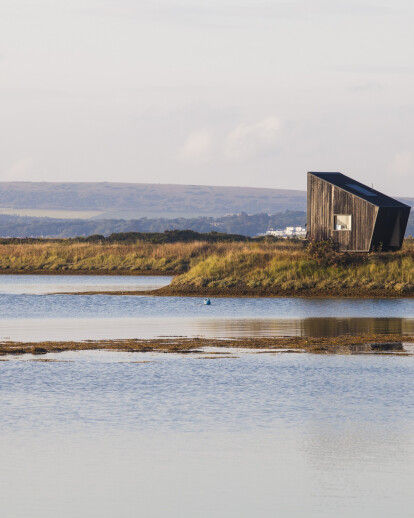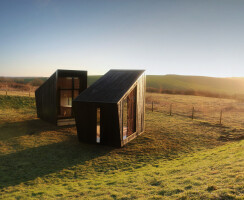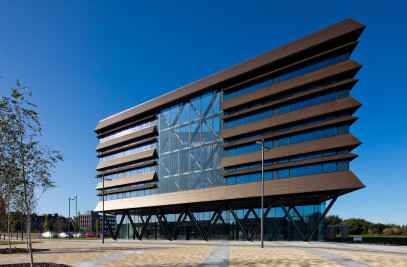"A look in and a look out for artist and audience"
The Observatory is a mobile artist studio and workshop designed to encourage interaction between artists and their audience, through a blurring of public and private and inside and outside spaces.
Four architectural assistants from FCBStudios (Charlotte Knight, Ross Galtress, Mina Gospavic and Lauren Shevills) together with Devon-based artist Edward Crumpton won a competition to create a structure that could house multi-disciplinary artists and directly engage with the public. They responded to the brief by creating two rotating wooden structures: • The Study: a private and weather-tight artist’s studio. • The Workshop: a space for the artist to present their work and encounter the public in. The team was inspired by the geometric forms of Sol de Wit and a 15th century painting Saint Jerome in His Study in which the viewer looks into the framed space of the artist, with a landscape framed beyond.
With these ideas in mind, The Observatory frames the artist’s space inside and its surrounding landscapes outside. Artist or audience can rotate the buildings, which like telescopes, can face new points of interest – a nod to the coastal defence ‘look out’ structures often found along the British coastline.
Dark charred timber panels, created using a Japanese technique called ShouSugi Ban form the external cladding. This richly textured, outer layer contrasts with the smooth lighter woods used inside the cabins. Edward Crumpton’s knotted and tarred marlin rope screen adds further decorative detail that will weather beautifully over time.
The Observatory will occupy four locations across the South of England over a two year period, giving twelve artists the opportunity of a two month residency each. A wood-burning stove provides heat, the solar panel on the roof is enough to power a light bulb and a laptop, and rainwater harvesting supplies the artist’s sink with water.
Testimonials
"This is a great example of architecture and art engaging the public.The client and architect achieved much with a low budget and many constraints and the result is playful, creative and much more than just a pavilion or folly." RIBA South Awards, Judges’ comments
"We were impressed by the imaginative response to the brief... and by the provision of much-needed research into the durability of charred timber." Wood Awards 2015
Brief: In 2014, SPUD, (Spaces, Place making & Urban Design), launched a national design competition for the Observatory, with the aim of creating a sculptural installation that would serve as a shelter and a look-out for twelve artists in residence over two years.
Designed in collaboration by four architectural graduates and one artist, The Observatory consists of a pair of rotating cabins forming an artists’ studio exploring remote landscapes along Britain’s South coast. The Observatory, inspired by Antonello da Messina’s ‘Saint Jerome in his Study’, creates a single point perspective which slices through the plan of each cabin to frame views of the landscape beyond. With the help of a concealed mechanism, the gentle turn of a wheel rotates the oversized viewing frame to capture a cinematic view of each other and of the landscape. This dialogue allows the artist and public to connect outside of conventional exhibitions and to explore together the emerging intellectual approaches between us and our natural world.
Planning: Thanks to the Observatory’s light touch approach it has been granted planning permission in a number sensitive locations, including two national parks, the South Downs and LymingtonKeyhaven Nature Reserve. The prefabricated Observatory has no ground fixings and requires the removal of only 10cm of top soil prior to installation.
Material and Construction: The Observatory is fabricated from a palette of hand crafted coastal materials: timber, tar, charcoal and hemp. The design team took a hands-on approach throughout the construction to develop a charring technique for the cladding and investigate the architectural application of ancient and modern wood technology using sustainably sourced timbers. This knowledge was then captured through a material research thesis. The Observatory was built off-site in 3 months and transported on a flatbed lorry from one site to another.
Timetable Dec. 2013: National Design Competition Apr. 2014: Winner announced Apr. to Aug. 2014 Project on hold, awaiting funding Sept. 2014: Planning awarded Oct. 2014: Construction (10 weeks). Jan. 2015: Site delivery Jan. 2015: First artist in residence (2yr programme)
Programme and Budget: Total cash expenditure on the design, construction and year one artist residencies was £120,500. Grant funding was supplied by Arts Council England (South West), Winchester City Council, Hampshire County Council, South Downs National Park Authority and New Forest National Park Authority. And the equivalent of approximately £50,000 was secured through commercial support from James Latham, Feilden Clegg Bradley Studios, S&S Construction and Unit Spark.
Contribution to Society: The public have direct access to the Observatory artists. Opportunities for engagement range from formal learning to chance encounters with the artists and the structures. Events including lectures, performances, installations, exhibitions and free workshops have so far involved over 2000 active participants and generated partners from local authorities, universities, schools and nature and conservation organisations. The Observatory is currently running community workshops on a sea wall in the New Forest National Park. It has acted as a remarkable catalyst for social and creative engagement particularly in the remote areas where it has been located.





































